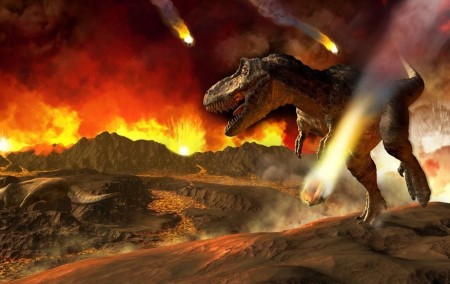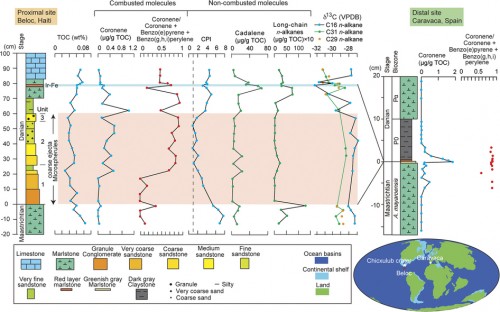July 19, 2016 – Over a cup of Earl Grey Tea last evening I met with a friend to discuss his work on the human mind. As we discussed Donald Trump and the state of the United States, he commented “we fail to learn from history.” I would like to extend that argument to “we fail to learn from the geological record and the evidence its history shows us.”
What I’m talking about is the results of a newly published research paper entitled, “Global Climate Change Driven by Soot at the K-Pg Boundary as the Cause of the Mass Extinction.” The story of the end of the age of dinosaurs has become well established in the last several decades as uncovered geological evidence points to a significant asteroid impact occurring near the present-day Yucatan Peninsula in Mexico. The impact is believed to have caused enough ejecta to block sunlight in the atmosphere interrupting photosynthesis in plants and leading to a mass die off. The discovery of a layer of iridium deposited in a thin layer marking the Creataceous/Paleogene boundary has been the smoking gun of this hypothesis.
But the new research adds another factor. The impact site is an oil-rich area and the asteroid’s impact and disintegration not only released vast quantities of its own material but also vaporized enough of the Earth’s crust to introduce sooty aerosols in the atmosphere which spread globally. The presence of particulate matter in significant concentrations caused global cooling, more significant in polar and mid-latitude regions, and milder cooling and drought in lower latitudes. The research hypothesizes that photosynthesis would have ceased on land as well as in the oceans within a few months and persisted for several years. Ocean surface temperatures would have dropped as well. These events induced both terrestrial and marine extinctions with the latter happening later than the former, a matter of just a few years delay.
The study describes a significant increase in infrared radiation as ejecta from the site of impact would have temporarily reached into space before falling back to Earth. This would have ignited fires in the oil-rich strata of the crater and released hydrocarbon aerosols as opposed to what previous paleoclimatologists surmised. The older theory of the extinction event describes the impact causing sulfuric acid aerosols leading to global darkness and an equivalent to a nuclear winter accompanied by acid rain. The new theory of hydrocarbon aerosols, state the researchers, explains why crocodilians, turtles and many other animals, including birds and a number of mammals made it through and soon dominated the land, water and air.
So where is the evidence of a hydrocarbon soot to be found? The scientists found incomplete combusted hydrocarbons in coarse-ejecta beds in Haiti and Spain. These were in proximity and lay above the iridium layer of ejecta from the asteroid itself. The composition of these hydrocarbon sediments forming a black carbon includes coronene, benzopyrene, and benzoperylene (see graph reproduced from the study below).
These hydrocarbons are similar to ones found in rock at the crater impact site. The particular hydrocarbons indicate extensive combustion. The depth of the deposits found in association with the iridium layer at one of the sampled sites varies from 2 to 4 centimeters, and at other sites further from the impact crater dissipate. From measuring these sampled sites the researchers have calculated that the total amount of black carbon ejecta amounted to between 500 and 2,600 teragrams which equals between 551 million and 2.9 billion tons. And although the researchers believe the lower figure of ejecta would not lead to a dinosaur extinction event, the upper number when entered into climate models would be consistent with their demise along with significant marine extinctions.
The prior nuclear winter scenario of prolonged darkness, the researchers argue, would have led to much more significant extinctions including crocodilians, birds and mammals. But that didn’t happen. Hence the black carbon soot-aerosol explanation is a better fit for what actually ensued.
Recently I wrote about short-lived climate pollutants of which black carbon was one. The appearance of this research paper in juxtaposition with that posting makes this cause of extinction relevant to us in our contemporary world where we humans are producers of soot-aerosols that are contributing to climate change. So maybe we can learn something from history, after all, even one 65 million years in the past.



















